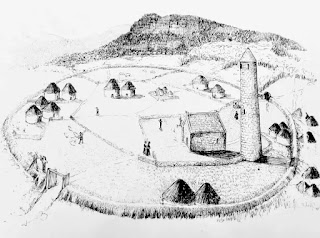The stretch of road between the Togher overpass bridge and Togher Cross has been the educational hub of Togher for well over 200 years! However education has existed in some form or other for thousands of years in the region. This first article in a series of 3 will look back on the history of education in Togher from ancient times up to 1820.
Introduction
Fosterage & Bardic/Monastic Tradition
Circa 1575
* Togher in common with the rest of Ireland was historically ruled over by a minor Sept , in this case , the Ui Mc Ceir. From an educational point of view children had two options ; Fosterage where the boy would be fostered by another family and learn practical skills such as horsemanship , animal husbandry , weaponry and farming whereas the girl would learn sewing , looking after animals and cooking. This prevailed for over two Millennia. It is highly probable that all children including adults were illiterate.
Only the elite ( centuries before and after the Norman Invasion of 1177 ) could afford formal education , which entailed either the Bardic Tradition of Irish language , Literature , History , Music and Brehon Law and produced Poets , Scholars and Historians who would entertain the noble Chieftains at their forts and later castles with storytelling and playing the harp ; or the later Monastic Tradition ( which for a time ran in tandem with the Bardic Tradition when Ireland was being Christianized from the 5th Century onward ) which instructed in Latin , Irish , Scripture , Metalworking , Bee Keeping and Agriculture , though a large part of their work entailed copying manuscripts onto vellum. Some monasteries would even educate the children of the Nobility.
Following the Cromwellian Invasion of Ireland in 1649 - 1653 , a system of Penal Laws were enacted , amongst them , the Education Act 1659 , which de facto prevented Irish children of the Catholic faith from receiving an education as no Catholic teachers were allowed to teach within Ireland. It was hoped that this would aid in the conversion of the population to the Anglican faith. However , in spite of this , a new form of teaching emerged in " Hedge " schools which initially were held in secrecy in forests and shady glens ( with each of the children taking turns on sentry duty ) away from the prying eyes of the new Protestant Ascendancy Class and their agents or in barns or quite literally under hedgerows , which gave them its name. Children were taught English , Irish , Arithmetic and the classics such as Greek and Latin. Typically , the teacher would receive some remuneration from the parents of the children. In practice though , many " hedge " schools were taught in the privacy of Patrons homes. Even when the Penal Laws were relaxed by the turn of the 19th Century with the introduction of the Catholic Emancipation Act of 1829 and the eventual introduction of the National Education Board of 1831 which allowed for the setting up of multi-denominational primary schools , many children still attended " Hedge " schools up to the 1890s. It is thought one such " Hedge " school was situated on the Pouladuff Road , which building still existed up to window sill level up to recent times. Its exact location cannot be determined. Another " fee paying " school , prior to 1831 , existed in Ashgrove , a sub-townland of Gortagoulane. The teacher , an Edmond Connor , had 50 pupils , 3 of them Protestant. The school was a dark , ill equipped thatched cottage. His salary per annum was the grand sum of £15 possibly paid for by local farmers. Again , this structure has not lasted the tests of time.
1820
Togher Cross








No comments:
Post a Comment